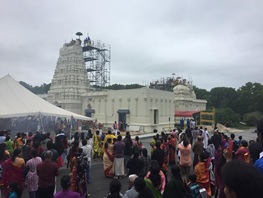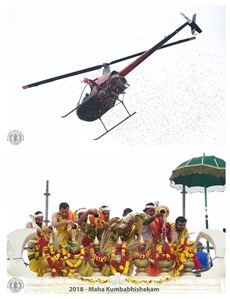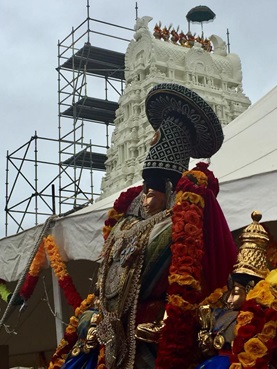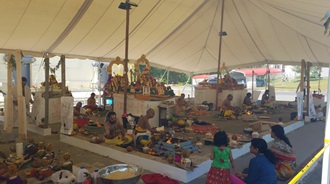Contribute
| Sri Lakshmi Temple Kumbabhishekam: A Few Reflections |
Ravi Vijayaraghavan
05/31/2018
Sri Lakshmi Temple Kumbabhishekam: a Few Reflections For nine days starting on 20th May and culminating with the wedding celebrations of Lord Venkateswara and Goddess Lakshmi on Memorial Day (28th May 2018), Sri Lakshmi Temple in Ashland was humming with activity and energy. The occasion was the Kumbabhishekam (holy consecration) of the temple, the fourth such celebration since the temple’s inception in 1978 and formal inauguration at its present site in 1990 (with worship as the New England Hindu Temple congregation preceding the same by about a decade). And for the Hindu community in the New England, this constituted some of the most precious dates this spring, and indeed for the full year, this celebration coming over twelve years since the previous event in 2005. The Kumbabhishekam occupies a special place in the history of all major temples (across South India, and especially so in Tamil Nadu): by tradition, it takes place about every 12 years and has as its primary purpose the sanctification and renewing the holy place of worship. But it is much more than that, an opportunity to dedicate new sanctums or facilities for the devotees, and an occasion for the entire community to come together as one in celebrating the event. For the Sri Lakshmi Temple, the Kumbabhishekam of 2018 served as the formal unveiling of the largest expansion in the temple’s history, with about 16,000 square feet of space including an auditorium, full-scale kitchen and dining facilities, as well as event and meeting spaces, making the temple as much a social center as a religious one. Further, extensive renovation work was carried out (especially in the sanctum of Lord Shiva and Goddess Parvathi), as well as necessary plumbing and lighting modernization, that together made for a significant three-year construction program. The centerpiece of the Kumbabhishekam, though, remains the yagnas or homams (rituals where religious offerings such as grains and natural woods are made into the fire, to the chanting of mantras) that are performed over a seven-day period in the dedicated tent structure (yagasala) temporarily built for this purpose. For this year’s Kumbabhishekam, this entailed full-fledged homams twice each day for each deity in the temple, a total of 21 fire pits (homa kundam) in all and led by a team of about 25 priests, many of whom had flown in from India and across America to perform the required rituals (and fully supported by Nadaswaram/Thavil vidwans). As a devotee, the sights and sounds of the homams in full flow across the yagasala, reaching a crescendo with the final offerings of each session (purnahuti and sathumurai) constituted the highlights of each day. The crowning evening, just before noon on Sunday, 27th May, was the auspicious bathing of the temple structure (gopuram and mandapams) as well as each idol of worship with the holy water that had been imbued with divine powers over the course of the homams. As tradition would have it, a lone eagle (Garuda, per mythology) circled over the temple at this anointed hour, and the helicopter showering the temple and devotees with rose petals right after the consecration itself provided a nice additional touch. The new auditorium hosted an 8 day series of daily music and dance programs by esteemed artists. As a long-time devotee and regular worshipper at the temple, three elements combined to make this a memorable occasion, and one to cherish in the years to come, perhaps all the way until the next one. First, the concurrent prayers and homams and celebration of all the deities in the temple, which occurs only during such Kumabhishekams. The normal course of events spreads these out over the year, for example Ramanavami in the early part of the year celebrating Lord Ram (Vishnu), Akshaya Tritiya for Goddess Lakshmi, and Ganesh Chaturthi in the summer, and so forth. When it is all happening together and all at once, the vibe and energy does make for a special experience. Second, it was striking to witness the scale (21 homams in parallel for 12 kalams (sessions) spread over 7 days) and sophistication with which the entire week-long festival was conducted, the culmination of months of planning and disciplined execution. From the careful identification and importation of required materials from India (from homam ingredients such as spices to textiles as well as silver and brass kalasams) and assembling a large set of priests well-versed in the rituals required to the arrangements for the care and feeding of devotees, it all came together flawlessly. Third, and perhaps most memorable of all, the two weddings (kalyana uthsavams) following the consecration which created a joyous and celebratory atmosphere to conclude the week-long event (and the years of work which preceded it). Per tradition, Sunday evening’s wedding ceremony of Lord Nataraja and Goodess Parvathi) is celebrated at this temple only following a Kumabhishekam, making it a long wait for devotees since the last such in 2005. The finale, Monday’s marriage of Lord Venkateswara and Goddess Lakshmi, was an elaborate and fun-filled event, drawing perhaps the largest participation of the entire week. There’s much more to come: the 48-day period (mandalam) following a Kumbabhishekam is a special period, marked by daily ritual bathing (abhishekam) of Sri Lakshmi and considered especially auspicious for devotees to offer prayers and seek blessings at the temple, even as other events on the Hindu calendar are observed and celebrated as per usual norms. Even as devotees reflect on and savor the functions we have had the opportunity to participate and witness over the past week, it is worth taking a moment to appreciate all those who made this happen for us. This has been a grueling stretch for a small number of people, especially the temple trustees, priests, and staff, starting with the initial fund-raising for the expansion to overseeing the construction and finally the consecration rituals themselves, and they deserve our sincere thanks. And most of all, the tens of volunteers who gave their time and energy and in many cases forsook their own desire to experience the Kumbabhishekam to help make the event possible … to all of you, a heartfelt thank you. Selected videos of Kumbhabishekam events can be viewed from https://www.youtube.com/channel/UCQICeUpgupaBEPa_MAr8Mag/featured
You may also access this article through our web-site http://www.lokvani.com/



